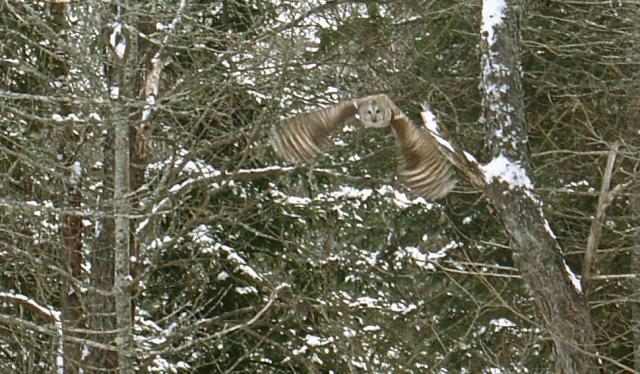2012 - Frog Bog Blog
Following a quite mild winter, the Spring of 2012 came early with record warm temperatures. In Muskoka, trees were budding and wood frogs were chorusing in the vernal pools well ahead of schedule. Much to the worry of early gardeners, a warm March was followed by lower temperatures through much of April. Unseasonably cold nights did help to hold back the black flies on the bog.
As we head into May, the days have grown warmer but the nights have remained cool. On a sunny day, with trees and flowers coming into bloom, our city yards have been filled with a profusion of butterflies.
Red Admirals have been plentiful, with many other species such as Question Marks also present (seen below on our purple sand cherry tree).
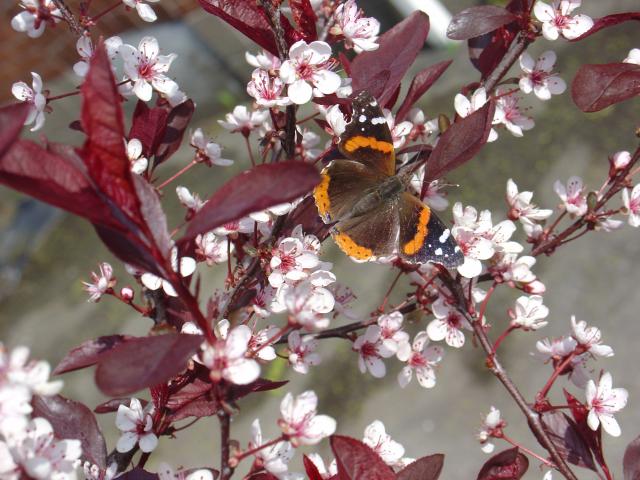


May 13-15
Lovely Spring days with cool single-digit nights -- everything was unfolding anew at the bog. Evening frog chorusing was everywhere, quite intense in pond areas, predominantly Spring Peepers, American Toads and Grey Tree Frogs. Veeries and White-Throated Sparrows sang well past dusk in the woods. It was nice to hear the Barred Owls calling in Frog Bog Alley again... unless, of course, you were a mouse or other small prey.
So much newness -- birds in the meadows, minnows running in the streams, perennials poking their heads up out of the soil and, inevitably, black flies and then mosquitoes. And then the appearance of the first dragonflies.
Our mild winter and early spring brought many early birds to Muskoka. Hummingbirds and pollinating insects are in daily search of flowers that seem to struggle to catch up with the season. I am always impressed with the importance of the humble dandelion in this early food chain. These yellow-flowered weeds attract a profusion of pollinators to the yard areas, including several large butterfly species, young hummingbird moths (too shy to photograph it seems :) and all manner of bee-like insects as well. I had the NaturCut Classic HD reel mower out on the lawn but the flowers were so dense with tiny insect life that I left some prime dandelion sections unmowed. Last Spring the dandelions attracted a memorable group -- hundreds of Red Admiral Butterflies landing en mass to feed!



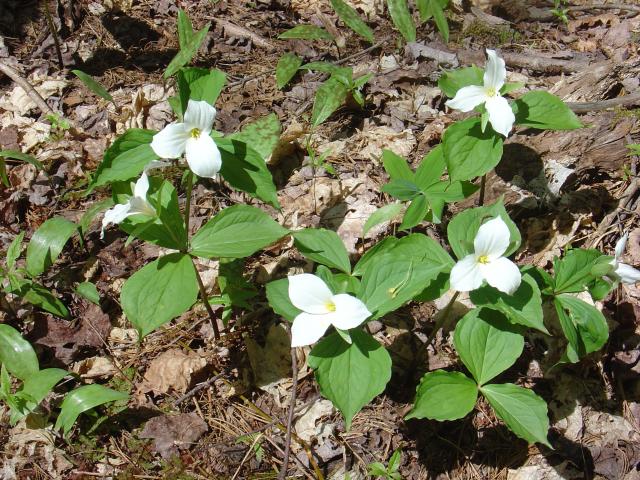
A walk through the woods in springtime reveals many new things. The sounds and signs of emerging wildlife are everywhere. The forest floor is covered with a variety of new plant life including countless Trilliums (below). The wetlands are much drier than normal for May, with the Black River already at lazy late-summer levels. I am hoping that predictions for a dry hot summer are somewhat over-stated.

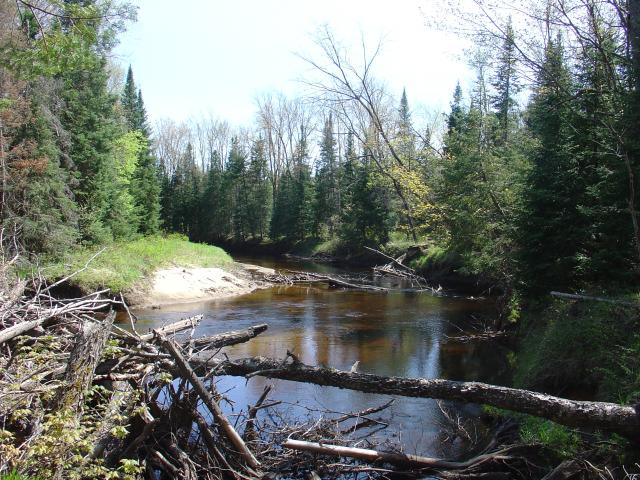
May 30, 2012
An amazing spectacle! I was out watering our front lawn in east Toronto, begging it to rain. It was grey and gusty and I was hopeful. Suddenly, a kestrel (small falcon) zoomed in on a group of sparrows that were desperately "making a break for it" off of the lawn across the street. The kestrel appeared to make mid-air contact with one of its prey about 20 feet in front of me. I jumped at the sight, spraying water towards the street in a reflex action. In that instant the startled birds parted, the kestrel going one way and the lucky sparrow making a narrow escape in the opposite direction.
June 2-5, 2012
Back at "the bog" in Muskoka for a bit of gardening, lawn mowing and exploring. There was some much needed rain over-night. We saw many interesting things including deer and wild turkeys in the meadow and an abundance of hawks. On the 2nd and 3rd of June there were glorious firefly displays in the yard. This is quite early in the season for them to show in such numbers and, in fact, by the 4th it was too cool at night for them to display any more (single-digit temperatures). Interestingly -- and perhaps a sign of the times -- there were still spring peepers chorusing at night as well. This was a bit odd because we have never observed fireflies when there are still peepers singing. Typically, the spring peepers stop chorusing a month or so before the first firefly is sighted. This year, the peepers are going longer and the fireflies are showing sooner.
June 13-16, 2012
I was able to find a few days and get up to the cabin to do some gardening. It was a beautiful, sunny day as I headed up the 400 and continued on to Highway 11 towards Bracebridge. I was in no hurry and decided to take the back-roads route to Vankoughnet. I exited Highway 11 at Cooper's Falls Road --- you never know what you might see passing through Housey's Rapids or Barkway.
Sure enough, I soon spotted a Painted Turtle, head erect, sunning itself in the roadway. Unfortunately, turtles are often attracted to the heat of the pavement and are obviously vulnerable to motor vehicles. While awareness of this problem is increasing, and in some places there are even marked "turtle crossings", the roadways are a major threat to species survival.
Normally when I see a turtle in such danger I will find a safe place up the road to pull over and park. These roads can be winding and heavily treed, so it is a very good idea to activate the emergency flashers. Keeping an eye out for traffic, the turtle can then be carefully removed to a safer location. Turtle experts suggest moving the turtle off the road in the direction it is facing. Painted turtles are much less daunting to move than Snappers and can be safely picked up behind the front legs.
Oh oh! As I started to get out of my car I noticed a pick-up truck towing a trailer fast approaching. I held my breath and hoped that the driver would see the turtle or perhaps miss it anyway (the reptile was part way across the lane and might just get lucky). Then the truck hit the poor animal. Was it my imagination, or did the driver change course slightly to make contact? Regardless, the turtle flipped three or four feet into the air then back down to the pavement. I let out a moan and hurried over to assess the damage.
Much to my amazement, the turtle appeared alert and active. I picked it up and held it at arms length as it urinated copiously (this is a normal reaction to unwanted handling or predation). There was no visible blood and the shell was intact with only minor abrasion around the edges. This was one tough, lucky turtle. Fortunately, the truck tire seemed to have only grazed the reptile, flipping it crazily. This may have saved it from contact with the trailer tires. I walked him off the road and into a rocky area with pools of water at the edge of the forest --- who knows, maybe he was planning on heading there eventually.
The rest of the trip was uneventful until I got close to the cabin --- then a female moose appeared at the edge of the highway, quickly changed its mind and ducked back into the safety of the forest. It was about 5 o'clock when I arrived and I did a bit of mowing to stretch my legs. This has been a long spring-time and the grass has been growing like crazy for months now. With the summer solstice a week away, the first tiny apples were now emerging in our mini-orchard but the summer flowers were far from blooming. Earlier in the spring it was the dandelions that provided a staple food for the butterflies and other pollinators that suddenly appeared with the warm weather. Now it was mostly Orange Hawkweed drawing these beautiful creatures into the yard. I carefully mowed around all of the wild flowers with the goal of creating my "managed meadow" (photos below).
The evening featured incredible firefly displays and sounds of nature coming from all directions!

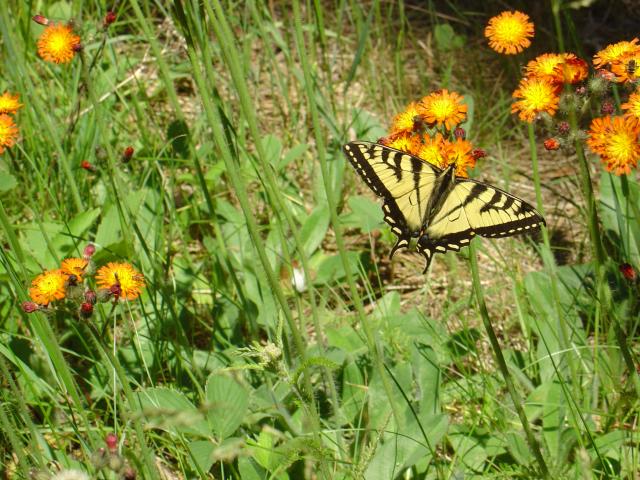
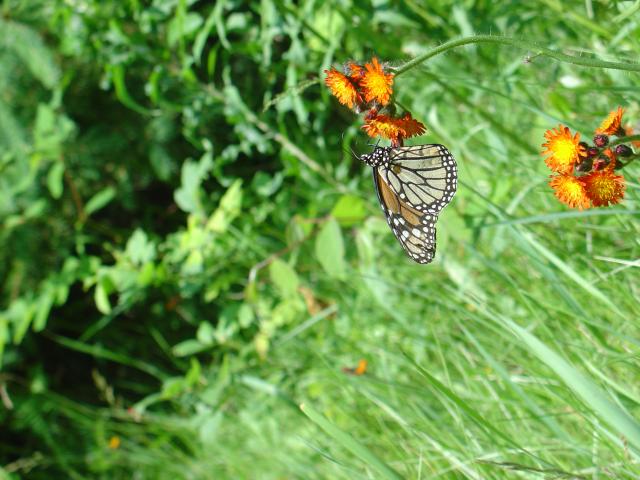
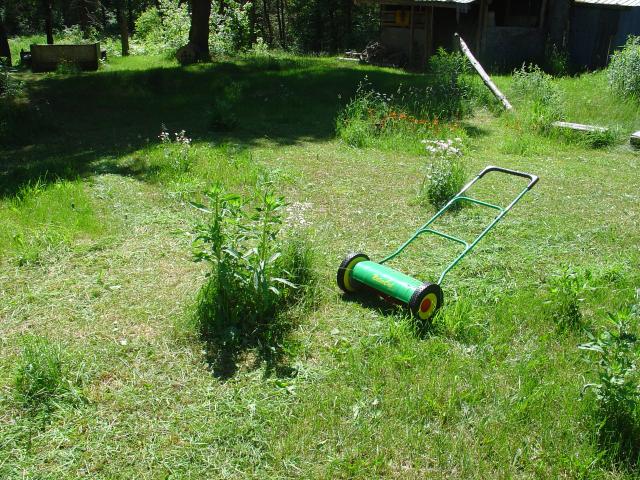
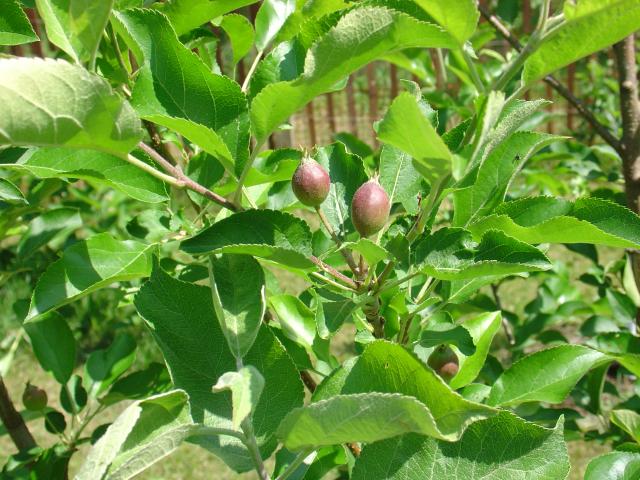
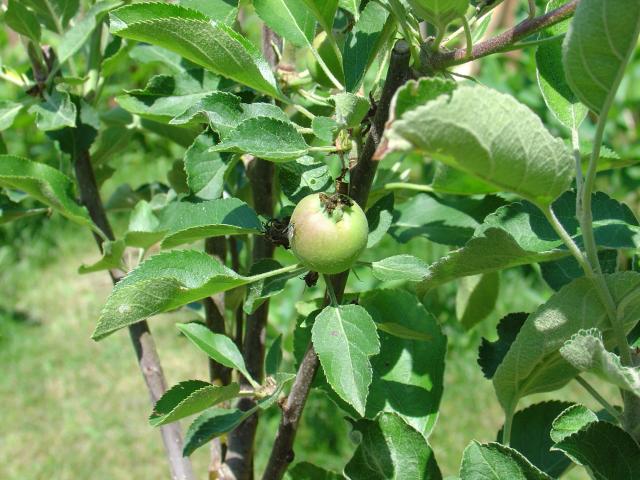


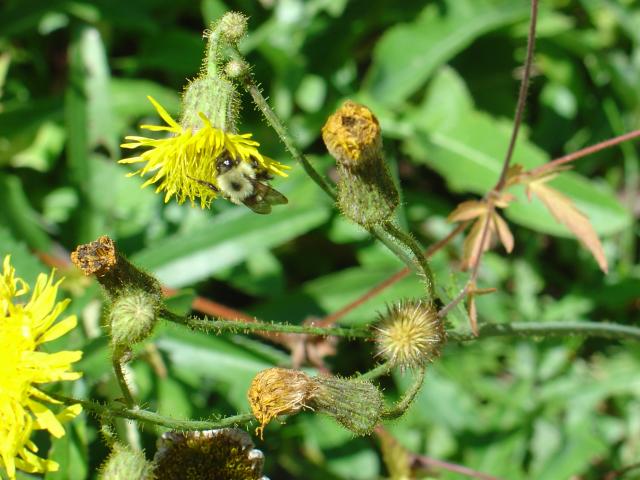
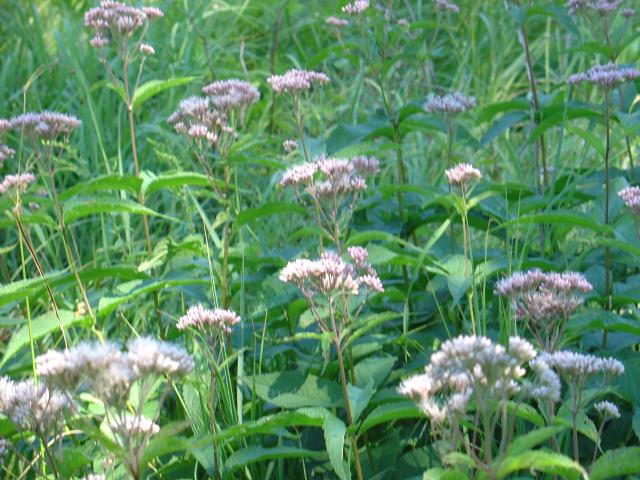
July-August, 2012
The province-wide drought continued through July with one or two crazy deluges of rainfall that created flooding problems in the city of Toronto. At the cabin in Muskoka, the Black River was the lowest I have ever seen it. It therefore came as no surprise to find the water in the well at a precariously low level too. Who would have thought this could happen at the bog?
Leopard frogs, normally abundant in the moist bog lawns and meadows, became quite scarce by mid-July. Because there were dried up ponds and few vernal pools, the green frogs were also much less numerous. Wood frogs seemed less affected, perhaps because they are very early spring breeders.
Everywhere the affects of the prolonged drought were obvious, from browning trees to fewer flowers, meaning less pollinating insects and humming birds, and so on. Nature was hunkered down, praying for rain.
And finally it did rain. And after an afternoon of strong to moderate showers, the sunshine revealed new flowers and meadows humming with renewed activity.
Clockwise below: The phlox is back in the upper meadow; one of many small northern bee-like pollinating species; new blooms along-side dried up flower heads are a bumble bee's delight; in the lower meadow the Joe Pye weed is not as thick as in other years but still attracts a wide variety of butterflies, including the camera shy fritillery.
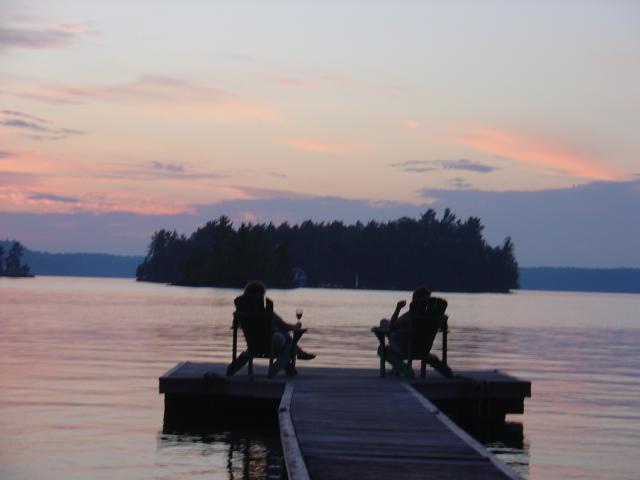
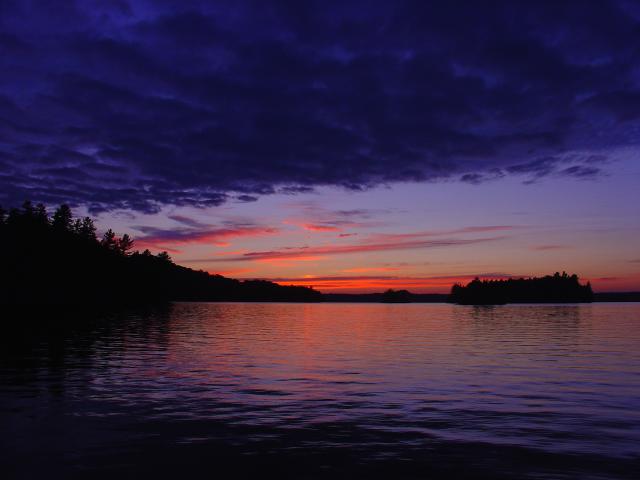
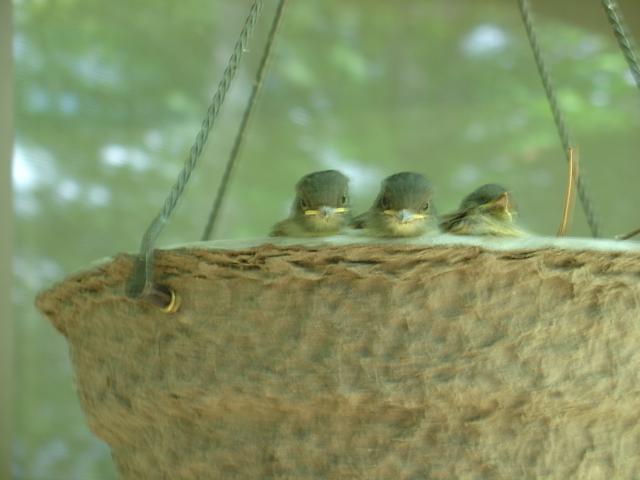
A visit to Skeleton Lake was an interesting side trip. We arrived just in time to see a trio of Eastern Phoebes fledge. These birds often nest around buildings and the parents may abandon the nest if there is too much human activity. Later on the sunset was fantastic, as were the loons calling from the lake.


Fall 2012
The leaves have fallen, but a warm day still brings out a garter snake for one last hunt (photo at right). On the other hand, a rare sighting of a long-tailed weasel was made easier because the animal was already sporting it's white winter coat. Within seconds, the agile mammal had disappeared behind a wood shed.
The driest summer in memory was followed by a rainy October and the tail-end of Hurricane Sandy. Our nearly dry well is looking much better and the drought-ridden Black River is now running fast and high again. What a difference a month can make! The first week of November brought signs of a cold winter ahead, but who knows?
Twenty twelve has been an interesting year for weather and nature observations. Spring came early and brought the fireflies out in numbers a good six weeks before their normal appearance in July. We had never before seen them while the spring peepers were still chorusing. Then, strangely, there was a small reappearance of fireflies in September, much later than normal.
Due to the drier conditions, amphibians had a leaner year than normal. This was especially true for green frogs and leopard frogs, species that are typically quite abundant. In a normal or wet year, leopard frogs populate the insect-rich meadow and lawn areas in much greater numbers than were observed this summer. And because there were fewer vernal pools and the ponds were smaller, green frogs had their range reduced to the immediate stream and river areas.
The dry weather undoubtedly affected large mammals as well. For example, there was certainly less evidence of black bears in the vicinity. Forest songbirds such as the veery and white-throated sparrow also seemed to be feeling the heat a bit. As a green landscaper, I can certainly relate to this and look forward to a bountiful 2013 season....
Below: A Barred Owl visits the meadow in early January, 2013.


